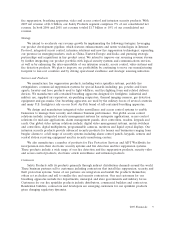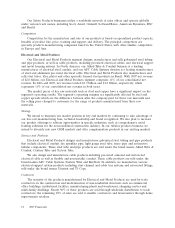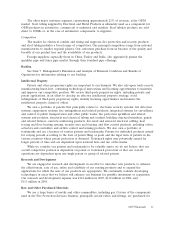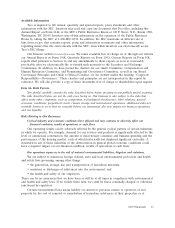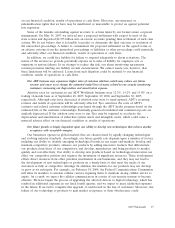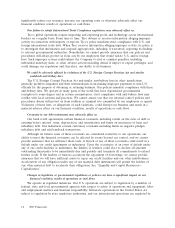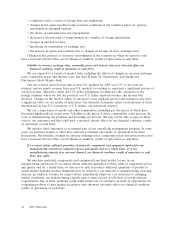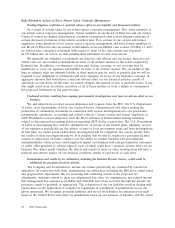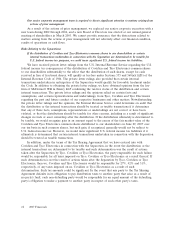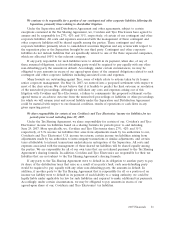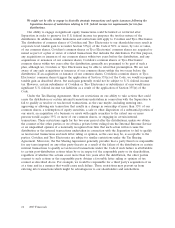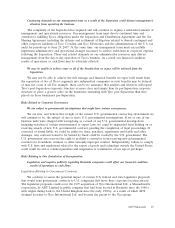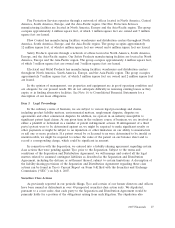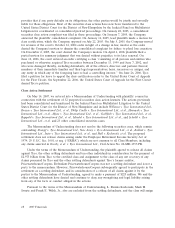ADT 2007 Annual Report Download - page 111
Download and view the complete annual report
Please find page 111 of the 2007 ADT annual report below. You can navigate through the pages in the report by either clicking on the pages listed below, or by using the keyword search tool below to find specific information within the annual report.Divestitures of some of our businesses or product lines may materially adversely affect our financial
condition, results of operations or cash flows.
We continue to evaluate the performance of all of our businesses and may sell businesses or
product lines. For example, in July 2007, the Board of Directors approved for divestiture Infrastructure
Services. Any divestiture could result in significant asset impairment charges, including those related to
goodwill and other intangible assets, which could have a material adverse effect on our business,
financial condition and results of operations. Divestitures could involve additional risks, including
difficulties in the separation of operations, services, products and personnel, the diversion of
management’s attention from other business concerns, the disruption of our business and the potential
loss of key employees. We cannot assure you that we will be successful in managing these or any other
significant risks that we encounter in divesting a business or product line.
We have disclosed a material weakness in our internal control over financial reporting relating to our
accounting for income taxes which could adversely affect our ability to report our financial condition,
results of operations or cash flows accurately and on a timely basis.
In connection with our assessment of internal control over financial reporting under Section 404 of
the Sarbanes-Oxley Act of 2002, we identified a material weakness in our internal control over financial
reporting relating to our accounting for income taxes as of September 29, 2006. For a discussion of our
internal control over financial reporting and a description of the identified material weakness, see
‘‘Management’s Report on Internal Control over Financial Reporting’’ under Item 9A, ‘‘Controls and
Procedures.’’
A material weakness is a deficiency, or a combination of deficiencies, in internal control over
financial reporting, such that there is a reasonable possibility that a material misstatement of the
Company’s annual or interim financial statements will not be prevented or detected on a timely basis.
We have determined that further improvements are required in our tax accounting processes before we
can consider the material weakness remediated. Management’s procedures and testing identified errors
that, although not material to the consolidated financial statements, led management to conclude that
control deficiencies exist related to tax effecting consolidating entries, analysis and reconciliation of
taxes receivable and taxes payable in non-U.S. jurisdictions, certain aspects of deferred taxes, and
procedures with respect to classification of tax amounts in the consolidated balance sheet. As a result
of these deficiencies, it is reasonably possible that internal controls over financial reporting may not
have prevented or detected errors from occurring that could have been material, either individually or
in the aggregate.
A material weakness in our internal control over financial reporting could adversely impact our
ability to provide timely and accurate financial information. While considerable actions have been taken
to improve our internal controls in response to the identified material weakness related to certain
aspects of accounting for income taxes, and further action steps to strengthen controls have been taken,
additional work continues to address and remediate the identified material weakness. If we are
unsuccessful in implementing or following our remediation plan, we may not be able to timely or
accurately report our financial condition, results of operations or cash flows or maintain effective
internal controls over financial reporting. If we are unable to report financial information timely and
accurately or to maintain effective disclosure controls and procedures, we could be subject to, among
other things, regulatory or enforcement actions by the SEC and the New York Stock Exchange,
including a delisting from the New York Stock Exchange, securities litigation, debt rating agency
downgrades or rating withdrawals, any one of which could adversely affect the valuation of our
common stock and could adversely affect our business prospects.
2007 Financials 19


